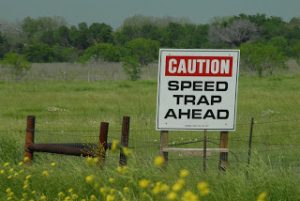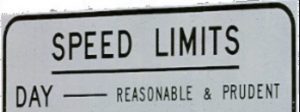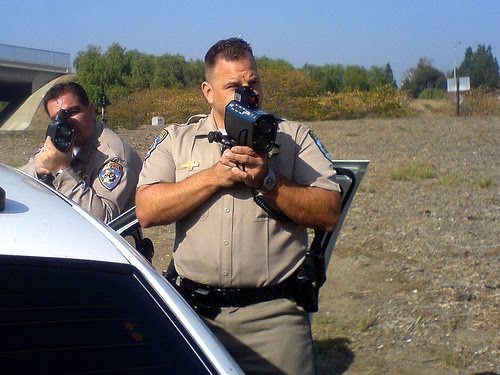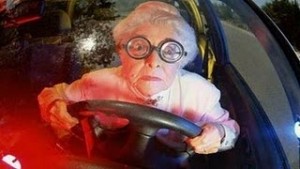A reader informs me that Pennsylvania is about to do what most other states already do: Empower local armed government workers to use radar to entrap “speeders.” In PA – at present – only state-level armed government workers are endowed with radar guns.
I dealt with more-or-less the same thing recently in my rural county, where the local sheriff’s office did not use radar until about a year ago. The county AGWs also drove old Ford Crown Vics. Then one day, a half dozen brand new “police interceptor” Explorer SUVs appeared in the parking lot – each equipped with radar.
I suspect a “grant” was acquired from Uncle to finance this; either that or the general rent we “land owners” are forced to pay in order to be permitted to continue living on the property we paid for years ago. 
At any rate, my reader asks me for my thoughts – and about how to fight this. I believe they only way to win this is to successfully challenge the concept of actionable speed limits as such.
Speed advisories are great; there is nothing wrong with letting motorists know that there is a curve up ahead which they might not be familiar with and that perhaps it’d be sound policy to reduce speed to “X.”
But enforceable arbitrary speed limits are a moral affront because they are no different than any other arbitrary rule – and laws ought to be premised on moral right/moral wrong.
It’s obviously wrong to just walk up to someone and hit them – and the law proscribing (and punishing) this when done is morally correct. Everyone understands this. We have a victim – someone who has been harmed. And we have a deliberate act, an intent to harm.
These are the basic elements of a crime.
Breaking a rule is not a crime – and treating a rule-breaker as a criminal is tyrannical. The rule-breaker who is punished becomes the victim and the government – that is to say, the busybodies and control freaks who constitute “the government – are the criminals.
Who has been harmed by the driver who proceeds at 56 MPH in a “55 zone”? To drive 56 MPH is rule-breaking “speeding” but almost never punished because everyone knows speed limits are arbitrary rules – including the armed government workers who enforce them. But they will usually arbitrarily enforce the speed limit only once the prospective victim is driving 61 MPH or 63 MPH in the 55 zone.
Why so?
Why is 61 any less arbitrary than 56?
The fundamental problem with rules, as a moral question is precisely that they are arbitrary – the codified and actionable version of a parent telling his kid to obey “just because I said so.”
The bright kid isn’t satisfied with this answer, for the obvious reason that it’s an evasion of an answer that comes down to nothing more than the threat of punishment for questioning it.
Actionable speed limits are just the same.
If you get pulled over for breaking the rule that decrees you must not drive faster than 55 and ask the armed government worker who you’ve harmed, the most he’ll be able to come up with is that your driving faster than the arbitrarily set velocity maximum is “unsafe” – but according to whom?
A generic, dumbed-down one. The unspoken standard is that if a Parkinsonian and Glaucomic oldster cannot handle driving faster than X on a given stretch of road without running off the road – or running into something – then everyone must be restrained to the same speed. This amounts to the same thing as a rule forbidding anyone from walking faster than a shuffling old gimp walks – and making it an actionable offense to attempt to get around the shuffling gimp.
It’s even worse, actually – because the Parkinsonian and Glaucomic oldster is a construct – a hypothesized person, not an actual one. The Parkinsonian and Glaucomic oldster hasn’t even crashed – because he doesn’t exist.
Nonetheless, everyone is held down to a presumptively dumbed-down standard premised on a fiction – and punished before any harm is caused on the basis of the assertion that a harm might result from driving faster than X.
It’s Byzantine and Kafkaesque – which dealing with rules always is. Common sense doesn’t enter into it. Hence the bureaucrat’s cynical riposte, “the rules are the rules.”
And the AGW’s “I’m just doing my job.”
But that ought not to be the basis for actionable laws – in a free society, that is. Which we are constantly told by those chewing away at freedom that it still is.
So, how fast should a person be allowed to drive? Or put a better way: How fast should a person be able to drive without it being an actionable offense?
As fast as he deems reasonable and prudent.
Which was once upon a time the actual legal standard in at least one state (Montana) until it was superseded by a rule-following regime imposed by the billy stick (i.e., Uncle threatening to “withhold” highway funding money already stolen from the residents of that state).
The beautiful thing about the reasonable and prudent standard is that it allows for the obvious, everyone-knows-it differences in individual skill and capability and becomes actionable only when it is clear – objectively indisputable – that the driver wasn’t driving reasonably and prudently.
Because he lost control of his vehicle.
QED, as the saying goes.
And the corollary is just as QED.
A driver who has not lost control should be presumed to be driving reasonably and prudently. This ought to be bulletproof as a legal argument, a slam-dunk defense against any trumped-up charge of “speeding.”
The fact that he may be driving faster than someone else feels to be reasonable and prudent is not evidence that isn’t.
Feelings ought not to be the basis of actionable laws.
Harm caused is the only objective standard.
Certainly, such a standard opens the door to risk.
Of course some people will not drive prudently or reasonably and cause harm – and such people ought to be held fully responsible for the harm they cause, because they are morally responsible for having caused it.
But no one else is responsible for harms they didn’t cause.
And by the way: The current regime doesn’t eliminate risk, either. This is the Utopia Pratfall – the unspoken premise of rule-defenders that their rules eliminate the problem – along with the demand that Libertarian alternatives must achieve perfection.
Some people will still drive unreasonably and imprudently, either way. The big difference is that the reasonable and prudent drivers are always at risk – under the rule regime – of being punished for nothing more than ignoring arbitrary rules.
Under the Libertarian system, they’d be left in peace – having not breached the peace.
Which brings us back to police radar.
It is merely a tool for enforcing arbitrary rules, for the purpose of mulcting the citizenry. An armed government worker sits in his car, pointing his radar gun at passing traffic – almost all of which is “speeding” to some degree because almost all speed limits are ignored to one degree or another because almost all speed limits are understood by almost everyone to be artificial, dumbed-down constructs.
Again this is something universally understood, if not universally acknowledged.
This particular AGW arbitrarily decides that 39 (in a 35) is “safe” today (another AGW might arbitrarily decide differently tomorrow) and so lets the cars which are “speeding” up to that arbitrary number pass by unmolested. But then a car passes by at 41 – and the AGW pulls its driver over and mulcts him for $100.
The 41 MPH driver did no more in terms of causing harm than the drivers who passed the gantlet doing 38 or 39. All of them broke the arbitrary rule – but the AGW enforced it arbitrarily upon the 41 MPH driver.
Tomorrow, it might be the 38 MPH driver. Or no drivers at all, because the AGW decided to set up his trap someplace else. Meanwhile, no harm is caused by the traffic flowing by his old speed trap at 40-something or even faster.
This goes on every day, in every town and city across the country. It has nothing to do with saaaaaaaaaaaaaaaafety. It has everything to do with the arbitrary enforcement of arbitrary rules.
The harm caused standard requires no radar guns to establish whether harm has been caused.
But there’s not much money – or power – in accepting that standard as the basis of an actionable offense.
Ayn Rand wrote about this problem. She wrote: “There is no way to rule innocent men. The only power any government has is the power to crack down on criminals. Well, when there aren’t enough criminals, one makes them. One declares so many things to be a crime that it becomes impossible for men t live without breaking laws.”
“Speeding” laws, for instance.
. . .
Got a question about cars – or anything else? Click on the “ask Eric” link and send ’em in!
If you like what you’ve found here please consider supporting EPautos.
We depend on you to keep the wheels turning!
Our donate button is here.
If you prefer not to use PayPal, our mailing address is:
EPautos
721 Hummingbird Lane SE
Copper Hill, VA 24079
PS: Get an EPautos magnet (pictured below) in return for a $20 or more one-time donation or a $10 or more monthly recurring donation. (Please be sure to tell us you want a sticker – and also, provide an address, so we know where to mail the thing!)
My latest eBook is also available for your favorite price – free! Click here. 














Absolutely spot on.
https://www.lewrockwell.com/2019/04/paul-craig-roberts/washington-has-destroyed-western-liberty/
Here’s a trigger happy pig who got what he DESERVED! Go here to warm the cockles of your hearts, fellas: https://news.yahoo.com/ex-florida-policeman-faces-sentencing-killing-black-motorist-141412657.html
This cross anyone’s line in the sand?
https://www.activistpost.com/2019/04/police-state-madness-cops-in-dui-vans-drawing-motorists-blood.html
If not, what would?
In a rare moment of sanity and commen sense, an unusual thing happened in our court house in Page county, Va. An over zealous AGW, Va state trooper had issued several speeding tickets for as little as 1 mph over speed limit. When the judge heard the first case of the morning from the first offender, he asked if any others had received citations from this particular state trooper. Several people stood up and the judge threw out the charges and them proceeded to chew out the officers ass. I doubt that will ever happen again with local and state governments trying to squeeze the last dollar out of the sheeple.
Hi Allen,
Such things happen every now and then; they even happened in the old Soviet Union, I gather! An overzealous Party Man would be chewed out for being overzealous. But the system kept doing its thing until the day came… der tag.
I hope it will komm soon here as well.
I’ll hazard a guess that the “Jidge” (how some of Babe Ruth’s teammates pronounced his given name, GEORGE) recognized an acquaintance in the courtroom. If he’d simply dismissed his friend’s ticket, probably no less bogus that the others, then the officer might have retaliated had it become known of the ticket holder’s friendship with the Judge. By making the issuing officer look ever as ridiculous as he was, he managed to cover his hiney.
Yes, “Virginia”, there ARE a few ethical and competent jurists out there…but sometimes it’s a case of folks whom otherwise would have been relieved of some of their hard-earned monies as well as assessed ‘points’ on their respective licenses benefited from a judge fixing a ticket for a friend and giving an overanxious pig some “what-fer”.
Stupidly low speed limits are rarely obeyed and even more rarely enforced, but this gives cops even more power. Anyone driving 56+ in a 55 is “fair game” but cops will choose their prey based on factors other than the velocity of the vehicle. It essentially gives them carte blanche to pull over anyone for any reason, cry speeding and point to a number on a box as proof, cry drugs and point to their nose as proof, then search the driver and the vehicle. If a cop really wants to, he can essentially search any driver at any time by just waiting for a speed limit to arbitrarily enforce.
Actually, the traffic citation is a sort of “consolation” prize…they’re necessary for the officer to fulfill his quota, no matter how much their existence is denied. What he’s looking for is further reason to detain and investigate…”I smell weed”…”Sir, have you been DRINKING?”…”You got anything on you that I should know about?”. Of course, in most states the officer has about an hour to have the K-9 unit show up before the stop is considered to be “unduly prolonged”, but, of course, the times will be ‘fudged’ if the arrival of the K-9 is delayed. And inevitably, the dog will ‘find’ something, assuming the handler isn’t so clumsy as to be obviously cuing the animal. Once the dog ‘alerts’, then they can search and make it stick…but what if there’s ‘nothing’ to find? Many times it’s like from “Analyze This”, where the mobster Paul Vitti’s (Robert DeNiro) goons have thrown a rival out the twelve-story window of his hotel room…he talks to his lieutenant, “Jelly” (Joe Viterelli) as an incredulous Dr. Sobel (Billy Crystal) looks on..
Dr. Sobel: Oh, now your gonna tell me it was a SUICIDE?
Vitti: Yeah, I think he even left a note. Jelly, did he leave a note?
Jelly: No, boss, but he will have.
Sobel: Oh! And let me guess what it says…life is bullshit, I can’t fucking take it no more, signed, ‘The Dead Guy!”
Jelly: Hey, Doc, dat’s good!
Yes: Combined with driving a realllly old car, and the cops think you are a drug user! So then, it’s just an excuse to pull you over and check you out. Has happened to my daughter twice in the old Subaru of mine she drives. Another thing I said, was I don’t care how shitfaced you are, falling over drunk, smelling like a brewery, etc., you NEVER, EVER say that you’ve been drinking.
Stupidly low speed limits are vehemently adhered to in Melbourne Australia. Especially those driving the newest cars and suvs. For a country that has the most open roads on earth, we actually have the lowest speeds of any country on earth, including the savage continent of Africa. People must have lots and lots of time to just throw away and increase their risk of an accident due to traveling too slowly and accumulating large amounts of fatigue. Australia is the most fascist country of the western world, not too long ago it was one of the most free countries on the planet. Scammeras and jihadis gave changed all that.
Not to mention caving and giving up your guns like you all did…
Unfortunately that is likely to happen here in the U.S. as well.
I’m afraid you’re right. These ‘red flag’ laws are all the rage, and a lot of REPUBLICANS are involved in their passage! I was just surprised that the Aussies gave up their guns without a fight like they did though…
Hey to5,
So, does the opening scene in Wolf Creek 2 resonate with Aussie drivers?
This video picks up right after 2 cops give a fraudulent ticket to Mick Taylor.
https://www.youtube.com/watch?v=YSc-NilMLvs
Warning, very gory.
Cheers,
Jeremy
Yes, Jeremy, and not just Aussie drivers. Even non drivers. It was gory but enjoyable nonetheless.
Yeah, VERY enjoyable! My favorite part was where the pig says he can make the ticket go away, and Mick Taylor say maybe he can make him (i.e. the pgi) go away before he torches ’em…
There’s no laws or speed limits, it’s all just criminals ripping off the public, because the public is not organized enough to protect themselves. That’s what America has become.
The safest speed with the most compliance is a highway engineering principle called the 85th Percentile Speed. It is the speed at or below which 85% of vehicles travel on an open stretch of road in good conditions. It is determined by a speed limit study conducted by professional highway engineers. The posted speed limit should be an indication to all drivers of the speed of traffic. It doesn’t matter what the politicians post as a limit: people are going to drive the 85th Percentile Speed because it is the safest speed, and people drive at a speed they feel safe.
The enforcement-for-profit cabal think we are 4 wheel ATMs and cash cows to be milked so they put out the propaganda that “SPEED KILLS” when that is a lie to justify their nation-wide multi-billion dollar ticketing regime that now includes speed cameras and red light cameras.
motorists (dot) org has pertinent info.
Long before I knew government gamed every number from CPI to temperature records I learned that speed studies were also gamed. There are the correct ways to do them and then there is the government way. The government way makes sure the speed limit is low. Even when the studies still don’t turn out the way government wants even though they were rigged they can have the professional highway engineer simply pull a number out from his ass.
So which states are lenient towards speeders and where it’s not criminal
I gotta get the **** outta Dirty Jersey asap
Hi Zane,
It is a nice day today; if I can get a little time later, I am going to roll the Rex out for a quick run. there is a stretch of straight road near me – almost 1 mile, with good sight lines – that I can hit 160 toward the end of if I get a good running start.
I consider this a categorical imperative . . .
I did 100 plus on NJ 29 more times than I can count! Just outside of Frenchtown, 29 was freshly paved when I had my ZRX; it was black ice. I loved nothing more than to go down there, and open her up… 🙂
MarkyMark,
Sweet, that’s a pretty area of the country, for Jersey especially…I used to camp out that way at a state park called Bull’s Island, on the river. Jump off the footbridge at Lumberville and swim.
Years later I’d ride out from the shore (Brick) on the first hardtail chopper I built, just to ride through that area: up 29, past Stockton, Frenchtown, Milford to Easton and back down 32 on the PA side, past Lumberville, to New Hope and then home.
Just to be in the wind…good times.
Yeah, I know Bull’s Island! It’s a nice ride. What you can do is make a loop; you ride one way on PA 32, cross the river, then ride back on NJ 29… 🙂 Or, if you’re riding a bicycle, you can ride the D&R Canal trail on the Jersey side, then head back on the Delaware Canal on the PA side.
Eric,
I understand your point here and am in basic agreement with you. That said, what about residential areas where children live? You don’t want people traveling at high speeds where children are. How should that be handled?
Install speed bumps. Works in parking lots.
Hi Mark,
This is an example of What If? thinking – the same species of argument used by (among others) gun-grabbers. We can’t allow teachers to carry in schools! What if a student got the gun and killed people?
Und so weiter.
I am not positing a risk-free Libertopia. Such a place does not and will never exist. However, we can end the use of violence against people on the basis of What if? – which seems like a sound idea to me.
I’m not a gun grabber, Eric-far from it. I’m hardcore, 2A all the way; I think ALL gun laws are unconstitutional! My position on guns reflects the Founding Fathers’ position: if you won’t trust someone with a gun in public, then they should NOT be on the streets in the first place. Their position was, if someone is so bad that they can’t be trusted with a gun, then they can’t be trusted with their freedom, either. Yes, I’m that radical when it comes to guns!
I guess my question is this: how do we find a balance? Can we live without regulation at all? In the neighborhood where I grew up, the PSL was 25; for a residential neighborhood, I thought that was reasonable. Even so, particularly on the heavily trafficked streets, many folks would go considerably faster than that. Do you want people doing 40-50 down a residential street while your kids are out playing? Like you, I don’t have kids; if I did, my answer to the preceding question would be resounding NO.
Should parents keep the kids away from the streets? Yes, they should. However, kids being kids will sneak out of the house. Even if they’re playing in the yard, a ball will inevitably get away, roll in the street, and the kid will chase after it. If someone is doing 50 down a residential street and a kid darts out in front of the driver, the driver will be fortunate to even recognize that someone is in front of him, let alone be able to STOP to avoid hitting the kid. The reaction distance will be long in such a scenario; also, because of the higher speed, physics says it’ll take more distance to stop.
Speaking of regulation, cars were built WITHOUT shatterproof glass at one time; at one time, that was ok! I know you’re also old enough to remember the Ford Pinto and its exploding gas tank; Ford made the decision that it would be cheaper to defend against lawsuits than it would have been to correct the faulty gas tank. I know that, when the Ford Pinto was designed and built, that gov’t was already regulating cars. What would Ford have done if there had been none?
Because of fallen human nature, folks will take shortcuts in the name of greed. Yes, the regulations we have now has gone way too far; on this, we agree. However, I don’t know if we can live without any at all, because there are too may who will NOT do the right thing. I think that one LEGITIMATE function of gov’t is to protect life; if they forbid Ford from building cars with exploding gas tanks, I have no problem with that.
History teaches us that anarchy isn’t the answer; even if it were to work, some better organized, more governed group WILL overrun the peaceful, anarchistic group. However, history also teaches us that gov’t left to its own devices will harm and eventually kill its people; more often than not, gov’t WILL devolve into tyranny. It’s Lord Acton’s power corrupts and absolute power corrupts absolutely coming into play here. How do we find a good balance between the two? Is it even POSSIBLE? I don’t know that it is.
I’m just curious, how many of those pinto gas tanks actually exploded? Do you know that economic calculation is a routine part of every human interaction and every engineering and management decision?
If you didn’t know, the Pinto case had a couple of bolts which if hit from behind exactly right could sometimes puncture the gas tank. Ford remedied this, and calculated that it was so unlikely that it wasn’t worth going back and trying to fix such an unlikely scenario. I can’t fault their reasoning- I remember the pinto being a pretty good little econobox for its day.
I would humbly contend that what the articles of confederation and the bill of rights attempted to bequeathe us was a simple anarchy- a system without rulers, where an individual could do pretty much as he pleased unless he caused harm. Thus Franklin’s quote about this form of government being suited only to a moral and righteous people- and wholly unsuited to a corrupted one.
Hi Ernie,
Twenty seven deaths were attributed to exploded gas tanks. I haven’t been able to find how many exploded in total. Cheers, Jeremy.
Thanks for that. The next thing I would wonder is how many of those 27 would have happened anyway vs Pinto’s slightly flawed design? It looks like they made around 2.08 million pintos in the years 1971-1975, so the risk was not large, or statistically significant.
My point being that Pinto was NOT a deathtrap, that government rules were NOT a fix. Not to diminish the suffering of any victim, but every activity involves some risk. And the pinto thing has chapped my arse since we studied it in engineering ethics 30 years ago!
Best,
Ernie
I think Franklin said, when asked what they’d given the people, he said, “A republic, if you can keep it.” I think it was Madison who said that the Constitution was suited only for a moral and religious people. I think he was 100% RIGHT about that…
I’m aware that tradeoffs have to be made all the time. I worked doing QC at an electronics manufacturer, so I’m aware of the calculus involved.
And yes, the Pinto was a decent little econobox 40 years ago. I liked the wagon’s look. I always liked 2 door wagons such as the Toyota Corolla, VW Fox, or the Pinto…
With you on the look of the wagon. A high school girlfriend had one, cute little wagon, the 4 speed and RWD was great and the little inline 4 was way better than the competing vega and gave a lot more heat than my Karmann Ghia. You got me on Madison- I’m pretty easy to trip on details like that but should have looked it up.
You remembered the quote, which is the main thing. It’s the truth behind the quote that matters, and history has borne out how RIGHT Madison was…
I think that the Articles of Confederation would have been better, because the central gov’t powers were limited. If the Founders had tweaked the Articles in Philadelphia vs. crafting the Constitution, then things would have only been better for a somewhat longer period of time. Had they tweaked the Articles, I’d think that, at the minimum, they’d have instituted a common currency, no tariffs for member states, and free movement for US citizens-IOW, something like today’s EU. Well, we know how THAT turned out, don’t we?
I read an article about the Pinto last year. It seems there were 3 or 4 other cars that were more dangerous being made at the time. That stat comes from wrecks in which every model car is involved and injuries and fatalities. I bet you can find it with a search although I don’t recall where I saw it….maybe LRC.
A VW was certainly no bargain in a collision and the early Jap imports were not very crashworthy either.
Surprisingly the much-maligned Gremlin did pretty well for a small car at the time in crash tests. Compare the Pinto-vs-LTD crash with the Gremlin-vs-Ambassador:
https://www.youtube.com/watch?v=YiNjZLEgAiY
The Pinto wasn’t a great car but for its time it wasn’t terrible either. It certainly didn’t suffer from the severe engine and rust problems that Vega owners had to deal with.
“Ford made the decision that it would be cheaper to defend against lawsuits than it would have been to correct the faulty gas tank”
That’s a myth. A media fabrication. Ford was commanded by the US Federal government like all other automakers to do certain calculations prior to a mandate. The fedgov decided what a human life was worth and the automakers then calculated the cost of a mandate vs. the federal government assigned cash value of the lives saved. If the mandate cost more than the value of the lives the mandate would not be put through. That is the calculation Ford made with regard to proposed fuel tank protection mandates.
See: http://www.pointoflaw.com/articles/The_Myth_of_the_Ford_Pinto_Case.pdf
Brent,
I took a look at that article, and I downloaded it. I’ve gotten to page 7. On the footnotes at the bottom of page 6, note 12 says that the Pinto did badly in the initial fuel tank tests. It goes on to say that, after the Pinto was rolled out, that it CONTINUED to do badly in subsequent fuel tank tests. While I understand that cost/benefit analyses are done all the time, this was one where Ford BLEW IT.
I know, I know; only 27 died. If you were one of those 27, what would you think? How would you feel as you’re burning alive from a FORESEEABLE accident? The first two people to die were rear ended at about 30 mph impact after their car stalled on the CA freeway. Dying by fire has got to be one of the WORST ways to go…
In any case, my original point still stands: if a company (in this case, Ford) would make a calculation like that under the aegis of NHTSA rules, what would they do in the total absence of regulations? What would most companies do? How do we strike a balance between too little and too much?
FMVSS was a copy and paste of SAE standards. That’s how it began. So there would be no difference with an absence of NHTSA. As note 12 indicates there was no standard at the time so it is difficult to judge the performance. Fedgov claims it granted us safe cars but all it did was take over an existing mechanism.
What if it was me? Well I spent a fair amount of my childhood travels in a Vega and the Pinto and the Vega weren’t all that much different in their performance in this regard. Perhaps even worse. So what we are dealing with is a level of knowledge in the early 1970s on how to make a car of this size perform well in a crash. It hadn’t been done. Especially when hit by something much bigger.
It may be a foreseeable crash type but the question is what could be done with it given 1970s knowledge? Ford is still held to account on the Pinto yet Tesla Motors gets away with obvious issues with its “autopilot” which a car need not have. A Pinto needed to be small and that’s what caused its problems and problems that were class wide. The only option at the time was to buy a bigger car.
I don’t think Tesla should be given a pass for its fires. Not only do they go up when hit; even sitting still they can catch fire! Eric has a video posted on here where a Tesla in a parking garage went up by itself and took out at least two other cars with it. It was just sitting in the parking stall, and poof! Up it went in flames…
As for the Pinto, I remember that there was a lot of media attention, so maybe that’s why I remember it more.
I am not saying TM should get a pass, only that they do. TM vehicles have IMO glaring defects that shouldn’t be tolerated from any automaker. Yet TM gets praise for things other automakers don’t have. Why don’t other automakers have them? Because their internal engineering procedures prevent them going into products.
Hi Brent,
So much of this is subjective – and no one else’s business. It is not as “safe” to ride a motorcycle that meets every federal fatwa vs. a “defective” Pinto… assuming I crash the bike. If I don’t crash the bike, it is as “safe” as an S-Class Mercedes. Same goes for the Pinto.
Neither the bike nor the Pinto are inclined to crash – which strikes me as the only relevant consideration. The “safest” vehicle is the one that never has to demonstrate how crashworthy it is.
The whole industry – and not just the industry but society, or rather those who control what we’re allowed to do and told not to do in the name of “society” – is premised on a pathological aversion to exaggerated risk. Everything from “our safety” to “terr” (as The Chimp puts it). A continent full of nail-biting ninnies – imposing their neurosis on everyone.
I remember reading a story many decades ago in Indiana. A woman was transporting herself and 3 children to a relative’s house an hour away. She was feeling sleepy by the end of the drive and then discovered all her children were dead. Carbon monoxide poisoning caused by a leaky exhaust system.
YOU do not want cars going over an arbitrary speed in a place where there are children.
There are many Adults which do not agree with you, because an arbitrary speed is a decision made by someone else which only applies to you, and not the person who made the decision.
This is known as allowing others to make decisions for you.
Adults like me NEVER want other to make decisions for them. Most of us are over 40 and have seen that the best decisions for us are the ones we make.
There has been no time in the last 50 years where something was put upon We The People that was a measurable benefit. Politicians are the most dishonest people alive, and history shows they violate their oath of office Daily.
So an Adult would not be stupid enough to believe in anything a politician does or says, including their rules and laws which are part of the Just-us cabal.
Say it again Farmer. OK, I’ll say it again. The Just Us system works for only one group of people. How do you know when a cop, lawyer, politician is lying? We all know the answer to that.
Why are chillun different from adults? Adults do stupid stuff that even chillun don’t sometimes do. There is no risk free society, and such a society would quickly die out and its people die of boredom.
What you mean by chillun? You tryna say chirrens? 😉
slang for children.
What folks really need to do is go look up your states statutes and see what the law really states. California traffic code specifically states that traffic violation are “infractions” which are civil not criminal. This means the police have no authority to stop anyone, the courts for traffic are administrative as well. Here in New Mexico yes the traffic laws are criminal, traffic signage is prima facie (suggested), the law is what is really controls the road. However when you look at the speeding statute, you have be guilty of breaking all elements the problem is “66-7-301, B.1 In every event, speed shall be so controlled by the driver as may be necessary: (1) to avoid colliding with a person, vehicle or other conveyance on or entering the highway;” if you are not in a collision you cant be speeding. Does not matter how fast you are going. Most folks wont take the time to look at the statutes or go to court to fight it.
ruleoflawradio.com Mon 8 pm
IME the written law doesn’t matter in traffic court unless you
a) hire a lawyer.
b) appeal to a higher court.
It is a rather lawless place.
By the time you do that, you’ll end up paying MUCH more than the fine itself; even including insurance hikes (for points violations), it’s a lot cheaper to just pay up vs. fighting the citation. If you can plead out to a non-points ticket, usually that’s the best you can hope for. In traffic court, you’re guilty until found guilty! Nice, huh?
And there’s the rub. As long as it is cheaper to just pay the fine it will continue. The times I’ve received tickets I’ve fought them and always had them reduced enough to pay for the time off work. But never eliminated completely unfortunately. The big thing for me is keeping points off my driving record. Might cause problems at work.
While that may technically be true, in real life it’s often the difference in getting a ticket and not. Most cops aren’t keen on breaking the cherry of someone that’s been driving a long time. Not saying they won’t, it’s just more unlikely they will if you have a clean record.
I’m living proof of it. I used to get speeding tickets on a regular enough basis I was just another speeder when I got stopped. Then I had nearly 6 glorious years with no traffic tickets. Was that ever a blessing. Of course I have slowed down, not to the point of not being ticketable, but down below steady triple digit speeds.
I found another thing that always got “someone else” a ticket when I was speeding and didn’t realize it till it played out in real life.
I bought a light blue Nissan 4wd pickup, a tiny thing and capable of 90 something with the larger wheels and tires I installed. It once, with the original worthless Wranglers and small wheels got to 106 coming downhill with a hard north wind to my back. Come 30.5X15 tires and that was all over but the locals would still give me a ticket. Most of the time though, especially in 4 lane traffic, I would be the guy setting off the gun at 90 something and some fancy, often speedy looking cars got pulled over.
I never seemed to be able to talk myself out of a ticket for speeding but did for a few other things. And it depended on whether the cop was close to my age. Driving a really hot car I was often pulled over for (name that charge)just so the cop(s) could look it over(you don’t have to turn it off if it’s gonna get hot). Yeah, sure, I’m certain you’re concerned. It’s probably not that high compression ratio, the special grind cam and the under the fender headers feeding side pipes for sure.
My experience also Brent. In traffic court the law is irrelevant. When I fought my ticket for refusing to wear a seat belt, I brought up Minnesota’s freedom of conscience article in it’s constitution. And pointed out that compelling an act on an unwilling individual is in direct violation of that. The judge said I don’t care and it doesn’t matter. When I pointed out that the Minnesota highway Staatzpolizei was speeding through my town in the dark, and I was sitting off to the side at a stop sign where he couldn’t possibly have seen inside my pickup, same judge still didn’t care.
The only thing these people understand is force. And so far, they think they’ve gotten away with all of it.
Oh Eric, the situation is even worse than you describe in some places. Here in CA, years ago, Geico and Allstate were buying the latest radar and laser guns for police departments. They even called it the “Hot Pad” program, where departments which were better at “enforcing safety” received more goodies. This came out about 20 years ago and caused outrage, and now, it’s just a matter of standard operating procedure and these grants to police departments are simply line items in quarterly earnings reports. I wish I could find those older articles, but that’s so far down in the ruins of the internet I can’t find it.
One speeding ticket here loses you your good driver discount, and results in a surcharge for three years. Your speeding ticket costs about $400 (for the cheapest, like 5 over) and then something on the order of $3,000 to insurance over the next three years. Yet another example of government collusion.
It’s time for pitchforks, torches, and perhaps tar and feathers, but that’s really mean.
Thanks, Eric. It strikes a blow for freedom!
The state I am living now now has a numerical speed limit of 75 on interstates and 80 on turnpikes. From 2016 to now, the posted speed limit was (and is) 70 and 75 mph, but there was no statutory limit. I was looking to challenging the validity of the posted speed limits in court if I had received a ticket. Enforcement, thankfully, is pretty light, so you can pretty much go as you please here.
I can tell you as someone who received his first and only “speeding” conviction in Montana in 1997, under the “reasonable and prudent” rule, I was selected out of a group for having a front license plate, i.e. out-of-state.
When I asked the Montana AGW what the speed limit was his answer was, and I quote, “these is no speed limit, but ya can’t do 95.” I had, in fact, done more than that earlier in the day, and quite safely, too. But it was what HE considered “reasonable and prudent”, and apparently, it was not reasonable and prudent for a stranger to do only 5mph more than the Montana State residents were doing in the right hand lane. Oh, and the fine was also payable, in cash, to the AGW/judge/jury/court clerk, on the spot. 2 years later a Montana resident was ticketed for the same, and won a dismissal on the basis of “absence of due process”, which, simply put, means a limit must be stated in order to be enforced and/or prosecuted. Montana posted speed limit signs within 90 days of that dismissal. I have my ticket framed, along with my photo of the sign declaring “No Speed Limit”. I will treasure it always.
Hi Graves,
Yup – and this is why I suggest the harm caused standard. It’s objective, it’s indisputable. You either did – or you did not. If not, someone’s hysteric feeeeeeeeeeeeeeeeling that you might ought to be no basis for interfering with you. But cause harm, and be held fully and solely responsible. I have never understood why anyone could object to such a reasonable approach…
The guy who fought the law and won in MT was doing something like 120 mph on a two lane.